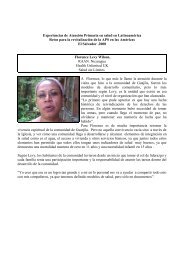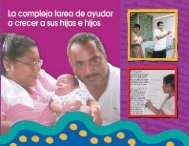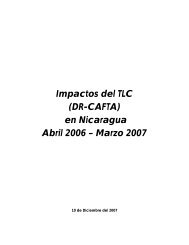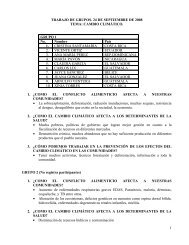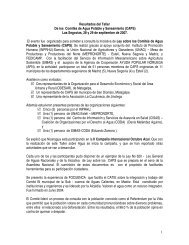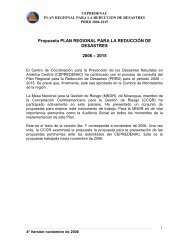A Gendered Analysis of the Social Protection Network in ... - CISAS
A Gendered Analysis of the Social Protection Network in ... - CISAS
A Gendered Analysis of the Social Protection Network in ... - CISAS
You also want an ePaper? Increase the reach of your titles
YUMPU automatically turns print PDFs into web optimized ePapers that Google loves.
<strong>of</strong> little importance to those implement<strong>in</strong>g <strong>the</strong> project. What is key is gett<strong>in</strong>g children<br />
<strong>in</strong>to school, <strong>the</strong> education <strong>the</strong>y receive <strong>the</strong>re appears to be <strong>of</strong> less, or little concern.<br />
In terms <strong>of</strong> health aga<strong>in</strong> <strong>the</strong> impact evaluation suggests targets were met or surpassed.<br />
However, once aga<strong>in</strong> <strong>the</strong> targets <strong>the</strong>mselves can be questioned. Results <strong>in</strong> terms <strong>of</strong> <strong>the</strong><br />
programme <strong>of</strong> ‘vigilance’ and promotion <strong>of</strong> growth and development (VPCD), that<br />
<strong>in</strong>cluded elements such as monitor<strong>in</strong>g weight ga<strong>in</strong> among babies under 3 years old, were<br />
said to have been 2 or 3 times better than <strong>the</strong> targets. It is important to remember that<br />
health services were contracted out to private providers and <strong>the</strong>y were paid by coverage<br />
and outcome (eg weight ga<strong>in</strong>). As <strong>the</strong> evaluation itself notes this suggests a conflict <strong>of</strong><br />
<strong>in</strong>terest.<br />
Ano<strong>the</strong>r element monitored under <strong>the</strong> VPCD was proportion <strong>of</strong> children under 3 years<br />
<strong>of</strong> age who had been given an iron supplement to reduce iron deficiency. While anaemia<br />
is a serious problem <strong>in</strong> <strong>the</strong> country, iron supplements would not be necessary if a healthy<br />
diet was available to children or maternal health was improved. The goal provides a clear<br />
example <strong>of</strong> focuss<strong>in</strong>g on symptoms not causes <strong>of</strong> poor health, look<strong>in</strong>g for a quick fix<br />
ra<strong>the</strong>r than address<strong>in</strong>g <strong>the</strong> fundamental problem.<br />
The second health element be<strong>in</strong>g monitored focussed on <strong>the</strong> vacc<strong>in</strong>ation <strong>of</strong> children<br />
between <strong>the</strong> ages <strong>of</strong> 1 and 2 years old which showed a net ga<strong>in</strong> <strong>of</strong> 17.3% (compared to a<br />
target <strong>of</strong> 10%) after hav<strong>in</strong>g taken account <strong>of</strong> a general <strong>in</strong>crease <strong>in</strong> vacc<strong>in</strong>ation coverage<br />
dur<strong>in</strong>g <strong>the</strong> period <strong>in</strong> non RPS areas. What both <strong>the</strong> <strong>in</strong>crease <strong>in</strong> enrolment <strong>in</strong> schools and<br />
<strong>the</strong> take up vacc<strong>in</strong>ations suggests is, as noted above, <strong>the</strong> orig<strong>in</strong>al notion underp<strong>in</strong>n<strong>in</strong>g <strong>the</strong><br />
RPS <strong>of</strong> <strong>the</strong> need to change <strong>the</strong> behaviour <strong>of</strong> <strong>the</strong> poor was erroneous. School<strong>in</strong>g and<br />
health appear to be valued by <strong>the</strong> poor as much as any o<strong>the</strong>r group <strong>in</strong> society what has<br />
been lack<strong>in</strong>g <strong>in</strong> <strong>the</strong> past was not lack <strong>of</strong> <strong>in</strong>terest, but lack <strong>of</strong> access.<br />
The f<strong>in</strong>al element considered <strong>in</strong> <strong>the</strong> evaluation <strong>of</strong> phase I <strong>of</strong> <strong>the</strong> RPS was focussed on<br />
consumption <strong>of</strong> food as a proportion <strong>of</strong> total consumption <strong>of</strong> <strong>the</strong> family. The goal was<br />
<strong>the</strong> only one that was not to be measured by a percentage change, but ra<strong>the</strong>r stated as<br />
‘observe <strong>the</strong> tendency <strong>of</strong> <strong>the</strong> change’. Despite <strong>the</strong> lack <strong>of</strong> precision <strong>of</strong> <strong>the</strong> goal set, it is<br />
said to have been ‘achieved’ (see BID 2003 table 1.2). Although no explanation <strong>of</strong> how<br />
this goal was achieved, or what this means is given, some figures related to food<br />
expenditure are presented. The average ‘net impact’ <strong>of</strong> <strong>the</strong> programme <strong>in</strong> annual per<br />
capita expenditure is said to have been 25%, and <strong>of</strong> this 88% was spent on food - or <strong>the</strong><br />
equivalent <strong>of</strong> an <strong>in</strong>crease <strong>in</strong> US$64 per capita food expenditure (BID 2003: 7).<br />
These figures are difficult to <strong>in</strong>terpret. S<strong>in</strong>ce measur<strong>in</strong>g changes <strong>in</strong> food consumption<br />
would mean longitud<strong>in</strong>al household research it is perhaps safe to assume <strong>the</strong>y refer to<br />
expenditure with<strong>in</strong> <strong>the</strong> RPS on food related programmes, ra<strong>the</strong>r than <strong>the</strong> expenditure by<br />
households on food. If this is <strong>the</strong> case, <strong>the</strong>ir <strong>in</strong>clusion here suggests that it is be<strong>in</strong>g<br />
assumed that <strong>the</strong> resources given as part <strong>of</strong> programmes such as <strong>the</strong> RPS are used for <strong>the</strong><br />
purposes <strong>in</strong>tended. This is a problematic assumption.<br />
Even when resources are given <strong>in</strong> k<strong>in</strong>d ra<strong>the</strong>r than <strong>in</strong> cash, <strong>the</strong>y are not always used for<br />
<strong>the</strong> purposes <strong>in</strong>tended by <strong>the</strong> donors. While it is usually assumed that this is due to men<br />
ga<strong>in</strong><strong>in</strong>g control <strong>of</strong> <strong>the</strong> resources and us<strong>in</strong>g <strong>the</strong>m for personal consumption it is important<br />
to note that this is also not always <strong>the</strong> case. In fact resources may be ‘misused’ for good<br />
reason, <strong>in</strong> that <strong>the</strong> household may have different needs or prioritise <strong>the</strong>ir needs<br />
differently than policy makers. It is rational, for example, that <strong>the</strong> illness <strong>of</strong> <strong>the</strong> key wage<br />
10





